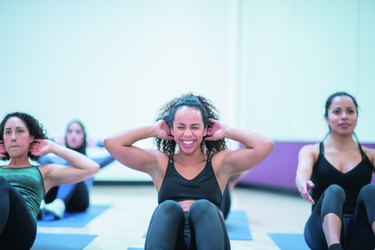
Once the gold standard of ab exercises, sit-ups have fallen out of favor as gym-goers look to more functional, full-body movements — like squats and deadlifts — to train their entire core more effectively and efficiently. Even the U.S. military has scrapped sit-ups from its physical fitness test.
But that doesn't mean classic sit-ups are totally worthless. They may not be the best way to build a tighter midsection, but doing them can help to illuminate certain weaknesses and muscular imbalances you may have.
Video of the Day
Video of the Day
Here, Ben Palocko, ACSM EP-C, a lead trainer at Trainiac, troubleshoots why you may struggle with sit-ups, plus offers alternatives on how to strengthen your core.
Read more: 3 Ab Exercises That Aren't Worth Your Time
If You: Have Back PainYou Might: Have a Weak Core
Feel pain in your back? "This means there's an imbalance of core strength, typically as a result of weak anterior core muscles (rectus abdominis and hip flexors)," Palocko says. As a result, "the lower back has to make an attempt to continue the movement and takes on more than it can handle."
If you feel discomfort in your back, don't force your body to go beyond the range of motion that feels comfortable, Palocko says. Instead, focus on doing other core-strengthening exercises, which will eventually help you progress to a full sit-up.
"For beginners, a basic floor crunch with feet elevated and eyes on the ceiling will activate the same muscles," Palocko says. He also suggests anti-rotation and anti-flexion movements (using a cable system or resistance band) like banded core rotations.
Banded Core Rotations
- Anchor the band at chest height and step away to create tension in the band. (You can also do this on a cable machine.)
- Grab the band with your right hand. Keep your right arm straight as you rotate to your right side.
- Control your tension and speed as you slowly twist back to starting position.
"Static movements like planks are also tremendous for core strengthening," says Palocko, who explains that moves that lengthen and shorten the muscles aren't necessary to adequately train the core. Planks in particular are killer ab exercises since they recruit a whole host of muscles on the front, sides and back of the body.
High Plank
- Lie on your stomach, hands under your shoulders and feet flexed, toes pressing into the ground.
- Push through your hands and toes as you lift yourself up so that your arms are fully extended and your body is in a straight line from head to toes.
- Hold for as long as you can with proper form. Once your hips start to sag or you lower back arches, lower back down, rest and repeat.
Tip
Too challenging? Drop to your knees or elevate your hands on a bench or sturdy chair. Nor hard enough? Drop to your forearms.
If You: Can't Keep Your Feet on the FloorYou Might: Need to Tweak Your Form
Do your feet tend to raise off the floor during sit-ups? If you always need someone to hold down your fly-away feet, you might just need to shift your body's placement to optimize your joint angle.
In other words, "muscles are stronger when the joint is at a more favorable position," Palocko says. And in this case, the best position means placing your feet farther from your body.
"I recommend walking your feet out a little further," says Palocko, adding that this minor adjustment can make a huge difference. People might be surprised that they're suddenly able to do a sit-up without their feet flopping around, he says.
Read more: 21 Sit-Up Variations You Won't Totally Hate
If You: Can’t Lift Your Torso Off the GroundYou Might: Have Tight Hip Flexors
Do you curl your shoulders off the floor just to get stuck mid-crunch? If, despite your abs' Herculean efforts, you still can't manage to lift your torso to complete a full sit-up, your hips may be to blame.
"Obviously, a weak core will make for a difficult time doing sit-ups, but weak hip flexors can more often be the culprit," Palocko says. "The hip flexors — including iliopsoas and rectus femoris — are responsible for stabilizing your hips and thighs as your torso travels upright. Thus, the movement chain becomes broken rather quickly if the hip flexors deactivate."
And when that happens, you'll find it super challenging to execute the full movement. How can you combat tight, weak hips? Start with stretches to increase flexibility and improve mobility.
Figure 4 Stretch
- Lie on your back and cross you right foot over your left thigh, bending your left knee.
- Pull the back of your left leg gently toward your chest.
- When you feel a comfortable stretch, hold for 30 to 60 seconds.
- Switch sides and repeat.
Stretching is only part of the equation. Palocko also recommends exercises like hanging knee raises to develop strength in the hip flexors.
Hanging Knee Raises
- Start by hanging on a pull-up bar with palms facing out. (You can also do these from a captain's chair.)
- Draw your shoulder blades down, keeping your shoulders away from your ears.
- Engaging your abs, lift both knees up toward your chest in a slow, controlled movement.
- Lower your legs slowly to return to the starting position.
Tip
If this move is too difficult, Palocko suggests doing simple standing single knee raises (using one hand for balance) to start building hip strength.
Read more: 7 Dynamic Stretches to Improve Hip Mobility